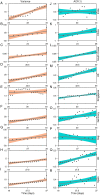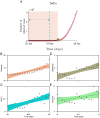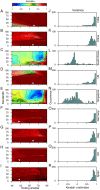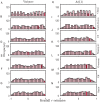Anticipating the Novel Coronavirus Disease (COVID-19) Pandemic
- PMID: 33014985
- PMCID: PMC7494973
- DOI: 10.3389/fpubh.2020.569669
Anticipating the Novel Coronavirus Disease (COVID-19) Pandemic
Abstract
The COVID-19 outbreak was first declared an international public health, and it was later deemed a pandemic. In most countries, the COVID-19 incidence curve rises sharply over a short period of time, suggesting a transition from a disease-free (or low-burden disease) equilibrium state to a sustained infected (or high-burden disease) state. Such a transition is often known to exhibit characteristics of "critical slowing down." Critical slowing down can be, in general, successfully detected using many statistical measures, such as variance, lag-1 autocorrelation, density ratio, and skewness. Here, we report an empirical test of this phenomena on the COVID-19 datasets of nine countries, including India, China, and the United States. For most of the datasets, increases in variance and autocorrelation predict the onset of a critical transition. Our analysis suggests two key features in predicting the COVID-19 incidence curve for a specific country: (a) the timing of strict social distancing and/or lockdown interventions implemented and (b) the fraction of a nation's population being affected by COVID-19 at that time. Furthermore, using satellite data of nitrogen dioxide as an indicator of lockdown efficacy, we found that countries where lockdown was implemented early and firmly have been successful in reducing COVID-19 spread. These results are essential for designing effective strategies to control the spread/resurgence of infectious pandemics.
Keywords: COVID-19; critical transitions; indicators of critical slowing down; non-pharmaceutical interventions; social distancing policies.
Copyright © 2020 Kaur, Sarkar, Chowdhury, Sinha, Jolly and Dutta.
Figures








Similar articles
-
Impact of self-imposed prevention measures and short-term government-imposed social distancing on mitigating and delaying a COVID-19 epidemic: A modelling study.PLoS Med. 2020 Jul 21;17(7):e1003166. doi: 10.1371/journal.pmed.1003166. eCollection 2020 Jul. PLoS Med. 2020. PMID: 32692736 Free PMC article.
-
First Wave of COVID-19 Pandemic in Italy: Data and Evidence.Adv Exp Med Biol. 2021;1353:91-113. doi: 10.1007/978-3-030-85113-2_6. Adv Exp Med Biol. 2021. PMID: 35137370
-
Could masks curtail the post-lockdown resurgence of COVID-19 in the US?Math Biosci. 2020 Nov;329:108452. doi: 10.1016/j.mbs.2020.108452. Epub 2020 Aug 18. Math Biosci. 2020. PMID: 32818515 Free PMC article.
-
[What is the effect of social distancing on the course of COVID-19 epidemic?].Pol Merkur Lekarski. 2021 Feb 24;49(289):71-79. Pol Merkur Lekarski. 2021. PMID: 33713099 Review. Polish.
-
Quarantine alone or in combination with other public health measures to control COVID-19: a rapid review.Cochrane Database Syst Rev. 2020 Sep 15;9(9):CD013574. doi: 10.1002/14651858.CD013574.pub2. Cochrane Database Syst Rev. 2020. PMID: 33959956 Free PMC article.
Cited by
-
Investigating the dynamics of COVID-19 pandemic in India under lockdown.Chaos Solitons Fractals. 2020 Sep;138:109988. doi: 10.1016/j.chaos.2020.109988. Epub 2020 Jun 10. Chaos Solitons Fractals. 2020. PMID: 32536763 Free PMC article.
-
The potential of resilience indicators to anticipate infectious disease outbreaks, a systematic review and guide.PLOS Glob Public Health. 2023 Oct 10;3(10):e0002253. doi: 10.1371/journal.pgph.0002253. eCollection 2023. PLOS Glob Public Health. 2023. PMID: 37815958 Free PMC article.
-
Factors associated with self-reported avoidance of harm reduction services during the COVID-19 pandemic by people who use drugs in five cities in the United States and Canada.Drug Alcohol Depend. 2022 Dec 1;241:109544. doi: 10.1016/j.drugalcdep.2022.109544. Epub 2022 Jun 24. Drug Alcohol Depend. 2022. PMID: 35779987 Free PMC article.
-
Early warning signals of infectious disease transitions: a review.J R Soc Interface. 2021 Sep;18(182):20210555. doi: 10.1098/rsif.2021.0555. Epub 2021 Sep 29. J R Soc Interface. 2021. PMID: 34583561 Free PMC article. Review.
-
Non-pharmaceutical interventions during the COVID-19 pandemic: A review.Phys Rep. 2021 May 23;913:1-52. doi: 10.1016/j.physrep.2021.02.001. Epub 2021 Feb 13. Phys Rep. 2021. PMID: 33612922 Free PMC article. Review.
References
-
- World Health Organization Coronavirus Disease 2019 (covid-19): Situation Report, 59. Technical report, World Health Organization (2020).
-
- Covid-19 Coronavirus Pandemic. (2020). Available online at: https://www.worldometers.info/coronavirus/
Publication types
MeSH terms
LinkOut - more resources
Full Text Sources
Medical

